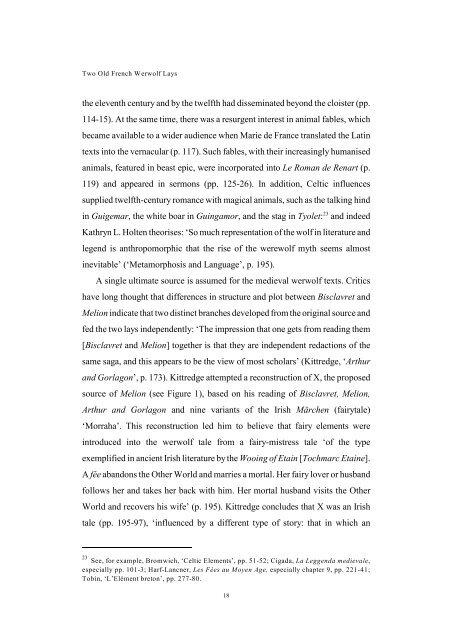Melion and Biclarel - University of Liverpool
Melion and Biclarel - University of Liverpool
Melion and Biclarel - University of Liverpool
You also want an ePaper? Increase the reach of your titles
YUMPU automatically turns print PDFs into web optimized ePapers that Google loves.
Two Old French Werwolf Lays<br />
the eleventh century <strong>and</strong> by the twelfth had disseminated beyond the cloister (pp.<br />
114-15). At the same time, there was a resurgent interest in animal fables, which<br />
became available to a wider audience when Marie de France translated the Latin<br />
texts into the vernacular (p. 117). Such fables, with their increasingly humanised<br />
animals, featured in beast epic, were incorporated into Le Roman de Renart (p.<br />
119) <strong>and</strong> appeared in sermons (pp. 125-26). In addition, Celtic influences<br />
supplied twelfth-century romance with magical animals, such as the talking hind<br />
23<br />
in Guigemar, the white boar in Guingamor, <strong>and</strong> the stag in Tyolet: <strong>and</strong> indeed<br />
Kathryn L. Holten theorises: ‘So much representation <strong>of</strong> the wolf in literature <strong>and</strong><br />
legend is anthropomorphic that the rise <strong>of</strong> the werewolf myth seems almost<br />
inevitable’ (‘Metamorphosis <strong>and</strong> Language’, p. 195).<br />
A single ultimate source is assumed for the medieval werwolf texts. Critics<br />
have long thought that differences in structure <strong>and</strong> plot between Bisclavret <strong>and</strong><br />
<strong>Melion</strong> indicate that two distinct branches developed from the original source <strong>and</strong><br />
fed the two lays independently: ‘The impression that one gets from reading them<br />
[Bisclavret <strong>and</strong> <strong>Melion</strong>] together is that they are independent redactions <strong>of</strong> the<br />
same saga, <strong>and</strong> this appears to be the view <strong>of</strong> most scholars’ (Kittredge, ‘Arthur<br />
<strong>and</strong> Gorlagon’, p. 173). Kittredge attempted a reconstruction <strong>of</strong> X, the proposed<br />
source <strong>of</strong> <strong>Melion</strong> (see Figure 1), based on his reading <strong>of</strong> Bisclavret, <strong>Melion</strong>,<br />
Arthur <strong>and</strong> Gorlagon <strong>and</strong> nine variants <strong>of</strong> the Irish Märchen (fairytale)<br />
‘Morraha’. This reconstruction led him to believe that fairy elements were<br />
introduced into the werwolf tale from a fairy-mistress tale ‘<strong>of</strong> the type<br />
exemplified in ancient Irish literature by the Wooing <strong>of</strong> Etain [Tochmarc Etaine].<br />
A fée ab<strong>and</strong>ons the Other World <strong>and</strong> marries a mortal. Her fairy lover or husb<strong>and</strong><br />
follows her <strong>and</strong> takes her back with him. Her mortal husb<strong>and</strong> visits the Other<br />
World <strong>and</strong> recovers his wife’ (p. 195). Kittredge concludes that X was an Irish<br />
tale (pp. 195-97), ‘influenced by a different type <strong>of</strong> story: that in which an<br />
23<br />
See, for example, Bromwich, ‘Celtic Elements’, pp. 51-52; Cigada, La Leggenda medievale,<br />
especially pp. 101-3; Harf-Lancner, Les Fées au Moyen Age, especially chapter 9, pp. 221-41;<br />
Tobin, ‘L’Elément breton’, pp. 277-80.<br />
18
















